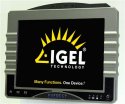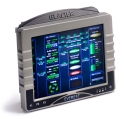First Linux on Everest
Sep 4, 2008 — by Eric Brown — from the LinuxDevices Archive — 4 views Linux thin client specialist Igel has created a Linux operating system image for a rugged panel PC designed for vehicle-mounted and industrial applications. The Igel-5310 LX Premium Image works with Glacier's Everest PC (pictured), available with a 600 MHz Celeron or 1.4GHz Pentium M processor.
Linux thin client specialist Igel has created a Linux operating system image for a rugged panel PC designed for vehicle-mounted and industrial applications. The Igel-5310 LX Premium Image works with Glacier's Everest PC (pictured), available with a 600 MHz Celeron or 1.4GHz Pentium M processor.
(Click for larger view of Glacier Everest)
The Igel-5310 LX Premium Image is one of three firmware stacks available for Igel's “Premium” line of thin client PCs, which falls in the middle of the company's Linux-compatible line-up of nine thin client models. Igel claims to be the third largest vendor of thin clients, which represent “super slimmed down” alternatives to desktop PCs. Accessing information stored remotely on a server, the devices generally have no moving parts and little memory while delivering the essential application capabilities of a PC.
According to Glacier, the Linux thin client version of its Everest “is designed specifically for software environments that require rich digital services, maximum performance, and security.” Glacier bundles the Igel Remote Management Suite with every Igel/Glacier thin client, says the company. The software is said to enable IT administrators to manage hundreds or thousands devices at once, and provides remote access to user profiles, device settings, updates, diagnostics, and support.
 Glacier Everest (Click to enlarge) |
Inside the Glacier Everest
Until now, the Glacier Everest has only been available as a Windows XP-based thick client, as reported on in this WindowsForDevices.com story. Typical applications include onboard forklift computers, warehouse walls, and shop floor data collection stations.
The Everest can be purchased with a 600MHz Celeron or 1.4 GHz Pentium M processor, and can be equipped with up to 1GB of DDR SDRAM, says Glacier. The units ship with a choice of either a 10.4- or 12.1-inch, SVGA (800 x 600-pixel) LCD screen with 5-wire resistive touchscreen. The display can be fitted with an optional sunlight-readable display, as well as a novel heated touchscreen that keeps the screen clear even when wheeled in and out of a freezer, according to the company.
The Everest's shock-protected 2.5-inch hard drive is available in capacities starting at 40GB. Peripheral interfaces include three USB 2.0 ports, two serial ports, an Ethernet port, and audio I/O. A combination of PCMCIA and mini PCI expansion slots can be populated with a range of options, including Bluetooth, 802.11a/b/g WiFi, WAN, and GPS.
In addition to the PS/2 keyboard/mouse ports, controls include three programmable function buttons and status LEDs. A custom diagnostic and configuration utility enables data logging and real-time monitoring of processor temperature and other critical system statistics. The 6-60 VDC power supply is said to include an intelligent UPS (uninterruptable power supply) function.

Everest (bottom view)
(Click to enlarge)
Stated Dirk Dordelmann, director, Augsburg Branch, Product/R&D Management, for Glacier, “This joint offering brings much more than just a Linux-based industrialized computer to end-users. With the addition of the IGEL image, Glacier customers will reap the increased security and manageability benefits of a thin client, while still being able to access all of their applications and data. This solution is a particularly good fit for shared desktop environments, such as manufacturing floors, because it allows users to login to their personal system from any device, giving them the freedom to roam.”
Availability
The Glacier Everest with the Igel-5310 LX Premium Image appears to be available now at an undisclosed price. More information on the Everest may be found here.
This article was originally published on LinuxDevices.com and has been donated to the open source community by QuinStreet Inc. Please visit LinuxToday.com for up-to-date news and articles about Linux and open source.